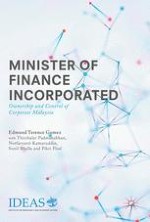Abstract
This chapter deals with a core question: what are government-linked investment companies (GLICs) and how do they function in the Malaysian economy? The chapter introduces the seven enterprises classified by the Malaysian government as GLICs, namely the Ministry of Finance Incorporated (MoF Inc.), Permodalan Nasional Bhd (PNB, or National Equity Corporation), Khazanah Nasional Bhd, Employees Provident Fund (EPF), Lembaga Tabung Angkatan Tentera (LTAT, or Armed Forces Savings Fund), Lembaga Tabung Haji (LTH, or Pilgrims Savings Fund) and Kumpulan Wang Persaraan Diperbadankan (KWAP, or Retirement Fund Incorporated). Four of these GLICs—EPF, KWAP, LTH and LTAT—are pension or special purpose funds, while PNB functions as an equity trust fund commissioned to redistribute corporate wealth equitably among all Malaysians. Khazanah is the country’s only sovereign wealth fund. MoF Inc., the government’s most important GLIC, functions as its investment holding arm.
The significant role that these GLICs play in the corporate sector became evident after a major scandal broke in 2014, involving another government-linked enterprise, 1MDB Bhd, a company closely associated with the then Prime Minister and Minister of Finance, Najib Razak. The 1MDB controversy was described by the British-based Guardian newspaper as “the world’s biggest financial scandal”, while the US Department of Justice released a report alleging that US$3.5 billion had been misappropriated from this government-owned enterprise. Some GLICs were involved in corporate ventures involving 1MDB.
These controversial issues relating to 1MBD and related government-linked investment-based enterprises draw attention to a core issue: the important role of GLICs in Malaysia’s corporate sector. Of equal concern is the nature of the state in Malaysia, which has been described by political scientists as a single party dominant state. This chapter briefly reviews the domineering presence of GLICs in corporate Malaysia and highlights the importance of the concepts of ownership and control that will be employed to assess how these companies function, particularly in a context where a strong state is in power. The methodology employed for this study is discussed, specifically the focus on ownership and control of publicly listed government-linked companies (GLCs) among the top 100 companies quoted on the domestic stock exchange, the Bursa Malaysia.
